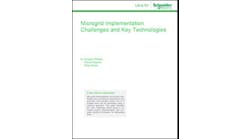Tim Qualheim, VP – Strategic Solutions, S&C
How can we really support grid modernization? One important step is the reclassification of energy storage. This is the view of many. including Tim Qualheim, S&C Electric’s vice president—strategic solutions.
Last year, President Obama issued a memorandum calling for a Quadrennial Energy Review, the first of which was released this May. More specifically, it includes insights on how to improve economic competitiveness, energy security, and environmental responsibility focused on energy generation, transmission, storage, and distribution. The review takes a look at threats and opportunities, and it offers suggestions on the policy changes that could best address these issues. The hope is to turn policy into action.
The report is comprehensive. For more information we suggest reading the White House’s press release from earlier this year. The suggestions we are most excited about include:
• State investment plans for a more reliable, efficient, and low-carbon electric grid
• Overall promotion of grid modernization and improved grid communication through standards and interoperability
• A new public-private partnership focused on climate resiliency and hardening the electric grid to improve reliability and security
• More rural electric infrastructure funding, including $72 million to support six new rural electric infrastructure projects that will likely address grid reliability and further adoption of solar generation in rural areas
With 100 years of industry experience and thousands of customers in the power industry, at S&C we naturally have a few thoughts about how modernizing the electric grid and our industry’s policies present significant opportunities to address national needs.
Fix how we measure
To improve reliability, grid performance has to be better measured. Today, our industry and its regulators measure grid performance using metrics like SAIDI and SAIFI, which measure sustained outage duration and frequency.
These regulatory and industry standards for measurement are as old as our aging infrastructure, but their flaws are more painful in today’s environment. For example, outages resulting from major storms aren’t included in SAIDI and SAIFI reporting, even when they cause devastating outages like what we have experienced in recent years. It’s difficult to make a case for the importance of storm hardening when baseline data exclude the worst storms.
Also, our old friends SAIDI and SAIFI completely ignore momentary outages. The billions of dollars that momentary outages cost utilities, businesses, and residential users are getting more difficult to shake off in a digital world and global economy. Momentary outages can be difficult to measure, so MAIFI metrics as they exist today are largely discounted.
We need to explore new ways to measure. Perhaps we consider regional metrics that will allow us to compare how a grid performs during severe weather and “blue sky” days. This approach could help us more accurately establish baselines, measure performance, assess areas of opportunity, and identify improvements to make. We could focus federal and state funding on the areas of best opportunity.
Reward for reliability
Reliability investments save businesses and consumers billions every year. Yet, utilities often receive no return on investment for improved reliability. With evolved measurement standards as mentioned above, utilities could establish accurate benchmarks and ultimately be motivated to improve reliability.
Reclassify energy storage
In the 1980s, when the utility industry formed its current structure separating generators, transmission operators, and distributors, no one anticipated the many benefits of energy storage.
Today, most states consider energy storage a source of generation, meaning those who operate transmission and distribution lines can’t own and effectively utilize energy storage. This approach is flawed because the multiple values storage provides on the distribution system will ultimately reduce overall electricity system costs. Energy storage is vital to grid modernization and overall energy infrastructure improvements, thus a reclassification is necessary to incentive utilities to adopt it.
How can we really support grid modernization? I would love to know not only what you think about the QER report, but what policy and other regulatory changes should be made to help modernize the electric grid. Should we reward for reliability and reclassify energy storage? How could we better measure to make either of those changes a possibility? Let’s discuss below.
Tim Qualheim, S&C’s Vice President—Strategic Solutions, is responsible for the strategy, direction and execution of S&C’s portfolio of solutions families. This article originally appeared on the S&C Electric Grid Talk Blog.







